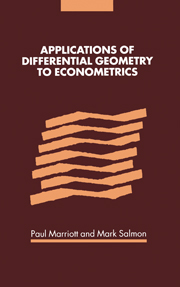Book contents
- Frontmatter
- Contents
- List of figures and tables
- List of contributors
- Editors' introduction
- 1 An introduction to differential geometry in econometrics
- 2 Nested models, orthogonal projection and encompassing
- 3 Exact properties of the maximum likelihood estimator in exponential regression models: a differential geometric approach
- 4 Empirical likelihood estimation and inference
- 5 Efficiency and robustness in a geometrical perspective
- 6 Measuring earnings differentials with frontier functions and Rao distances
- 7 First-order optimal predictive densities
- 8 An alternative comparison of classical tests: assessing the effects of curvature
- 9 Testing for unit roots in AR and MA models
- 10 An elementary account of Amari's expected geometry
- Index
Editors' introduction
Published online by Cambridge University Press: 09 March 2010
- Frontmatter
- Contents
- List of figures and tables
- List of contributors
- Editors' introduction
- 1 An introduction to differential geometry in econometrics
- 2 Nested models, orthogonal projection and encompassing
- 3 Exact properties of the maximum likelihood estimator in exponential regression models: a differential geometric approach
- 4 Empirical likelihood estimation and inference
- 5 Efficiency and robustness in a geometrical perspective
- 6 Measuring earnings differentials with frontier functions and Rao distances
- 7 First-order optimal predictive densities
- 8 An alternative comparison of classical tests: assessing the effects of curvature
- 9 Testing for unit roots in AR and MA models
- 10 An elementary account of Amari's expected geometry
- Index
Summary
Geometry has always aided intuition in econometrics but has perhaps only very occasionally aided analytic development. However, advances in statistical theory have recently been greatly enhanced through a deeper understanding of differential geometry and the geometrical basis of statistical inference; see, for instance, Kass and Vos (1997), Barndorff-Nielsen and Cox (1994) and McCullagh (1987), as well as a rapidly expanding array of journal articles.
What value do these advances hold for econometrics? How can practical econometric methods be improved by a deeper understanding of the geometrical basis of the problems faced by econometricians?
This volume attempts to stimulate the appetite of econometricians to delve further into the sometimes complex but always enlightening world of differential geometry and its application to econometrics. The reward we have found is not only a deeper appreciation of existing methodologies but the recognition that further advance in a host of different directions can readily be made. It is this potential gained through studying what may be standard problems from an alternative perspective that makes the application of differential geometry to econometrics so exciting. Geometry is mathematically fundamental, and frequently a geometric understanding of a problem highlights the essential issues which can be hidden in an algebraic development of the same issue. Take for instance the basic notion of orthogonal projection that underlies much of econometric and statistical method and its extension to curved statistical spaces and the question of invariance to different parameterisations, the interpretation of higher-order asymptotic expansions and statistical curvature and the role of ancillarity and exogeneity.
Information
- Type
- Chapter
- Information
- Publisher: Cambridge University PressPrint publication year: 2000
